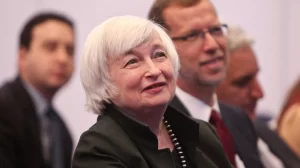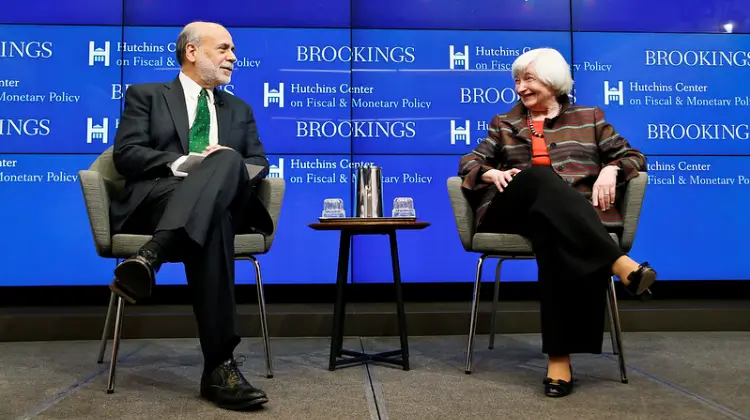Making history can seldom seem easier, except in retrospect. On January 06, 2014, the Senate voted 56 to 26 in favor of Janet Yellen as Chair of the Federal Reserve Board. Fed Chairman Janet Yellen took over for Ben Bernanke starting on February 01, 2014. The appointment as Chair of the Federal Reserve Bank is undoubtedly a major feather in Yellen’s cap. No less significant however, is the fact that Yellen becomes the first woman to head the FED in its one-hundred-year history.
- Read our Janet Yellen Biography.
The glass ceiling is a metaphor used to describe the invisible, but still existing, barriers that prevent women and minorities from rising to the upper echelons of business and other elite organizations. Despite their qualifications and experience, women and minorities often find it difficult to break through the invisible barrier that blocks their advancement. – See Glossary: What is the glass ceiling in finance?
How to break the Glass Ceiling in Finance and Economics?
There are a few key ways to break the glass ceiling in finance and economics. The first is to get an education in the field. Once you have a degree, it is important to get experience in the business field or from organizations related to economics and finance. This can be done through internships or working at a company in a related field.
The third step is to network with people in the industry. Meeting people who work in finance and economics can help you learn more about the industry and find job opportunities. Finally, it is important to be persistent and stay focused on your goals. Breaking the glass ceiling takes hard work and determination, but it is possible with effort and temperance.
Janet Yellen in the FED
As the fifteenth person to chair the Federal Reserve, Yellen is taking charge at a critical time for the economy and the banking sector. Yellen has served as the vice chair of the Federal Reserve since October 2010, where she supported Ben Bernanke, the outgoing chair of the Reserve, during a critical period for the U.S. economy.

She played a key role in supporting the economy, helping it recover from the financial crisis of 2008. As Fed Chairman, Janet Yellen, continued steering the Federal Reserve in the same direction as her predecessor. This included:
- Keeping interest rates at near record lows.
- Purchasing bonds each month to sustain the economy.
- Guiding investors about the likely direction of rates.
- Giving her support to Bernanke’s measures.
Ben Bernanke: The predecessor
Outgoing chair, Ben Bernanke, probably looked back on his two terms as chair of the Federal Reserve with mixed feelings. After all, who would enjoy being in charge when confronted with the worst financial crisis and recession since the 1930’s? Yet a slew of measures taken by Bernanke helped save the U.S. banking system from utter collapse. It came as no surprise that President Obama nominated Bernanke for a second term in 2010. In President Obama’s words, Bernanke’s background, temperament, courage and creativity have helped the nation avert the possibility of another occurrence of the Great Depression.
Appointed as chair in 2006, Bernanke advocated greater transparency in the Federal Reserve policy. The big jolt came two years into his first term when the Lehman Brothers defaulted on their $613 billion debt. This incident triggered a chain reaction in the financial system, nearly destroying the U.S. However, under Bernanke’s leadership, the Federal Reserve Bank rallied. It came up with innovative programs that helped the credit markets stabilize. The Fed took measures like:
- Lending money to banks and financial institutions when credit markets froze.
- Cutting its key short-term interest rates, bringing it extremely close to the zero percent mark.
- Buying bonds worth trillions of dollars to lower long-term borrowing rates.

Not everyone shares the same views on Bernanke’s handling of the economic crisis. Critics repeatedly point out his failures, particularly in the follow areas:
- Failing to foresee the approaching financial crisis.
- Focusing more on the roles of private banks and financial institutions and less on the role of the Federal Reserve.
- Bailing out Wall Street.
- Boosting the slow recovery by injecting an additional $600 billion into the banking system.
However, at the end of his tenure, Bernanke leaved the economy in a much better state than what it was before he served. This in itself would be an abiding achievement for a man who watched his country come perilously close to a financial collapse. Some of Bernanke’s achievements include:
- Increasing payroll employment by 7.5 million jobs
- Reducing the unemployment rate to seven percent as of November 2013
- Increasing GDP in 16 of 17 quarters with the GDP in the third quarter of 2013, standing at 5.5 percent – higher than its pre-recession peak
- Bringing industrial production and equipment investment back to their pre-recession peaks
A review by the Wall Street Journal (WSJ) sums up Bernanke’s tenure as being:
- A failure before the financial crisis.
- A success during the financial crisis.
- A mix after the crisis.
In conclusion, Janet Yellen has shattered the glass ceiling as chair of the Federal Reserve. She has shown that a woman can succeed in a field that has traditionally been dominated by men. Her tenure as Fed chair has been a success and she has made important contributions to the economy. I hope her example will inspire more women to pursue careers in economics and finance.
